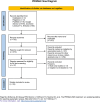Cannabis for female orgasmic disorder/difficulty: a systematic review
- PMID: 40808870
- PMCID: PMC12343064
- DOI: 10.1093/sexmed/qfaf061
Cannabis for female orgasmic disorder/difficulty: a systematic review
Abstract
Background: Cannabis is increasingly recommended to treat female orgasmic disorder/difficulty (FOD/difficulty), a condition that affects up to 41% of women worldwide with no conventional medications.
Aim: To systematically review the existing literature on cannabis and its impact on female orgasm function.
Methods: A systematic review based on the PRISMA model evaluated the effects of cannabis on orgasm function in females with or without FOD/difficulty. Risk of bias was assessed for randomized and nonrandomized studies. Searches were conducted in PubMed, Google Scholar, Cochrane, and Embase.
Outcomes: Primary outcomes focused on the impact of cannabis on female orgasm function.
Results: Sixteen studies met inclusion criteria: 1 randomized controlled trial and 15 observational studies, including data from 8849 females. Most were nonrandomized designs without comparator groups and high risk of bias. Most included both sexes and reported dichotomized outcomes by sex. None excluded females with self-reported orgasm difficulty; 1 controlled for its prevalence; 1 dichotomized females by the presence or absence of orgasm difficulty; and no studies used a clinical diagnosis of FOD. Nine studies investigated cannabis use prior to sexual activity. All 9 studies cited improvements in female orgasm function, including increases in frequency, ease, intensity, quality, and/or multiorgasmic capacity. However, 1 study found cases of situational anorgasmia, and 1 reported that women had more difficulty with focus, potentially leading to orgasm difficulty. Two studies assessed general cannabis use and sexual function: 1 found no association between the frequency of cannabis use and female sexual problems, while the other noted improved orgasm and reduced dysfunction with more frequent use. Five studies examined cannabis alongside other substances, before sex or not: 1 linked inhibited orgasm to combined cannabis and alcohol use, 1 to noncannabis substances, 2 found improved orgasm function with cannabis, and 1 reported improved orgasm function and cases of inability to orgasm due to a lack of focus.
Clinical implications: Cannabis appears to be a promising treatment option for FOD/difficulty.
Strengths and limitations: This review found consistent evidence that cannabis improves orgasm function in females with or without FOD/difficulty. Limitations include insufficient high-quality studies and limited reporting on cannabis dosage and timing.
Conclusion: FOD/difficulty should be recognized as a qualifying condition for medical cannabis use. Given the existing evidence supporting its potential efficacy, medical cannabis warrants consideration as a first-line treatment. More randomized controlled trials are needed to clarify optimal dosing, routes of administration, strain specificity, timing of use, and differential effects across FOD subtypes.
Keywords: cannabis; cannabis-assisted orgasm; female orgasm difficulty; female orgasmic disorder.
© The Author(s) 2025. Published by Oxford University Press on behalf of The International Society for Sexual Medicine.
Conflict of interest statement
None declared.
Similar articles
-
Prescription of Controlled Substances: Benefits and Risks.2025 Jul 6. In: StatPearls [Internet]. Treasure Island (FL): StatPearls Publishing; 2025 Jan–. 2025 Jul 6. In: StatPearls [Internet]. Treasure Island (FL): StatPearls Publishing; 2025 Jan–. PMID: 30726003 Free Books & Documents.
-
Psychosocial interventions for cannabis use disorder.Cochrane Database Syst Rev. 2016 May 5;2016(5):CD005336. doi: 10.1002/14651858.CD005336.pub4. Cochrane Database Syst Rev. 2016. PMID: 27149547 Free PMC article.
-
Home treatment for mental health problems: a systematic review.Health Technol Assess. 2001;5(15):1-139. doi: 10.3310/hta5150. Health Technol Assess. 2001. PMID: 11532236
-
Pharmacotherapy for anxiety and comorbid alcohol use disorders.Cochrane Database Syst Rev. 2015 Jan 20;1(1):CD007505. doi: 10.1002/14651858.CD007505.pub2. Cochrane Database Syst Rev. 2015. PMID: 25601826 Free PMC article.
-
Pharmacological treatment of children with gastro-oesophageal reflux.Cochrane Database Syst Rev. 2014 Nov 24;2014(11):CD008550. doi: 10.1002/14651858.CD008550.pub2. Cochrane Database Syst Rev. 2014. Update in: Cochrane Database Syst Rev. 2023 Aug 22;8:CD008550. doi: 10.1002/14651858.CD008550.pub3. PMID: 25419906 Free PMC article. Updated.
References
-
- American Psychiatric Association . Diagnostic and Statistical Manual of Mental Disorders. 5th ed. text rev. American Psychiatric Association Publishing; 2022.
-
- McKoy J. Many patients don’t discuss sexual dysfunction, distress, or pain with doctors. Boston University School of Public Health. May 26, 2023. Accessed June 5, 2025. https://www.bu.edu/sph/news/articles/2023/many-patients-dont-discuss-sex...
-
- Rowland DL, Tai W. A biopsychosocial model of female orgasmic difficulty: implications for research and treatment. J Sex Marital Ther. 2016;42(4):295–312. 10.1080/0092623X.2015.1063580 - DOI
Publication types
LinkOut - more resources
Full Text Sources
Miscellaneous


